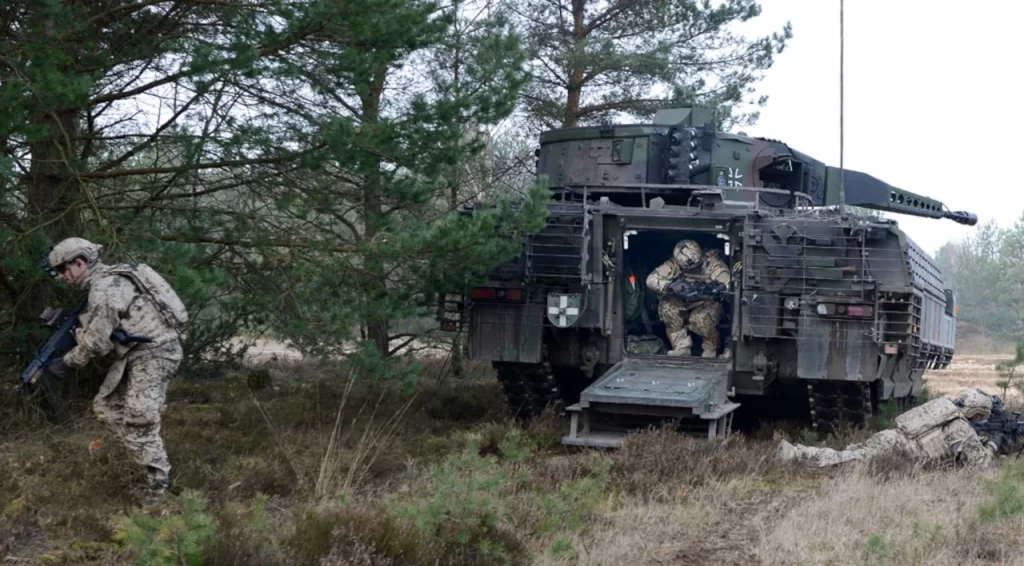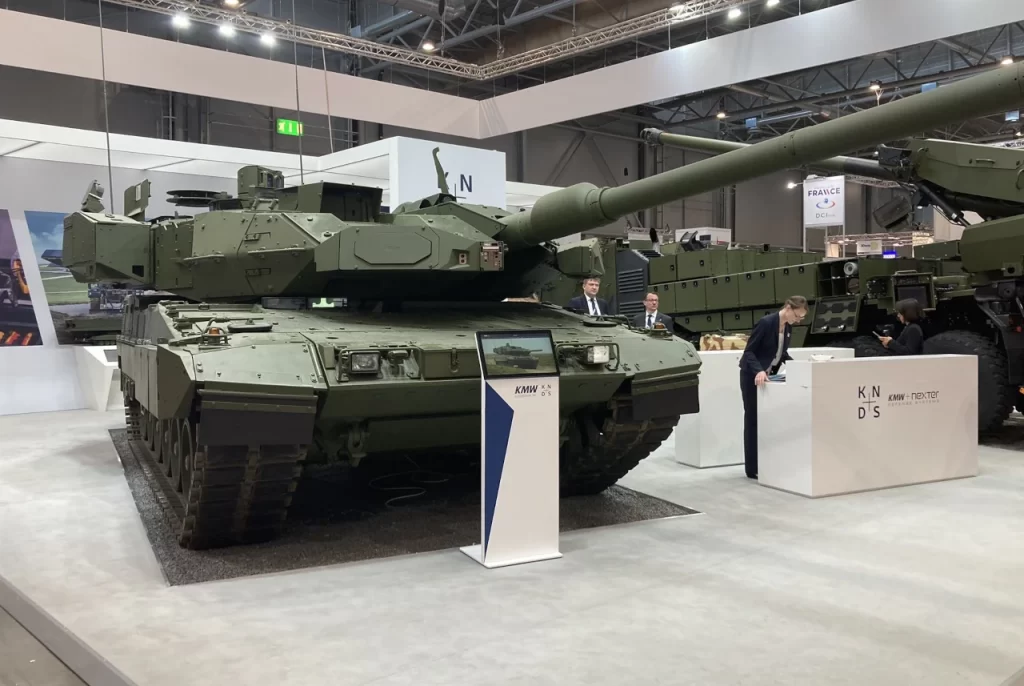On October 12th, KMW (Krauss-Maffei Wegmann) completed the delivery to the Bundeswehr of the final Leopard 2 A7V tank out of 104 that had been ordered. In October 2019, the German Army (Heer) received its initial tank. Annually, KMW is capable of manufacturing around 26 Leopard 2 A7V tanks.
The Heer undertook the Leopard 2 A7V initiative to modernise and unify different iterations of Leopard 2 tanks in their arsenal. Essentially, it entails new production, as design modifications and attrition necessitated the fabrication of new hulls and, in some instances, turrets. This pertains specifically to Leopard 2A4 tanks. In addition, forty-four Leopards in the A7V configuration have been ordered by Denmark.
KMW prioritises the A7V’s enhanced mobility, armament, protection, and manoeuvrability. Protection against weapons of mass destruction, sensors, command and control network system integration, and the capability to utilise modern tank ammunition are all essential components.
The final A7V tank was ceremoniously transferred from KMW to its headquarters in Munich. The timely and cost-effective delivery of all 104 tanks was a source of pride for Ralf Ketzel, the CEO of KMW. Ketzel asserts that the infantry combat vehicle (BVP) Puma and Leopard 2 A7V, equipped with digital command and control systems, will constitute the “digital hammer” of the Heer. This enhances comprehension of the battlefield and situational awareness not only for personnel but also for command.
During the Very High Readiness Joint Task Force (VJTF) exercise conducted the previous year, the rapid reaction units successfully established enterprise-level digital connectivity between Leopard 2 A7V and Puma.

For one year, Germany assumed command of the VJTF this year. Within hours to days, these forces are tasked with rushing to the assistance of allies in the event of a threat. The aggressor must be resisted by the VJTF until the preponderance of NATO forces are mobilised. It is one of the most difficult and accountable responsibilities in the Alliance; therefore, each year, a different nation assumes leadership of the VJTF.
Approximately 8,000 soldiers have been allocated by Berlin for the VJTF, the majority of whom are from the 37th Armoured Brigade “Freistaat Sachsen” (Panzergrenadierbrigade 37). The VJTF is equipped with Leopard 2 tanks and receives logistical, artillery, and transport support in addition to the Puma infantry combat vehicle. The VJTF comprises 11,500 alliance personnel, including individuals from the Czech Republic.
Bad Frankenhausen, Thuringia-based 393rd Armoured Battalion of the 37th Brigade, constitutes the central German element of the VJTF. This is the only battalion that possesses Leopard 2 A7V tanks in their entirety. Forty of the forty-four tanks in the German battalion are consistently operational in readiness for combat under their NATO commitment.
KMW will now concentrate on manufacturing and distributing Leopard 2A8 tanks (previously Leopard 2 A7NO) for Germany and Norway. Leopard 2 A8 is significant to several nations, including Sweden, the Baltic States, Italy, the Netherlands and the Czech and Slovak Republics.
Leopard 2A8
The Bundeswehr has placed an order for 18 Leopard 2A8 tanks and retains an alternative procurement option of 105 tanks, also available to foreign clients. As the situation progresses, conjecture surrounds potential modifications to orders and quantities. There are deliberations regarding the potential expansion of the Bundeswehr tank fleet beyond 400 units. Additionally, it is critical to modernise the remaining 88 Leopard 2 A5/A6/A6A1 tanks. The alternatives include procuring an equivalent quantity of brand-new Leopard 2A8 tanks or creating an enhanced iteration known as Leopard 2 Axe, which will integrate elements from the forthcoming Main Ground Combat System (MGCS).

According to its CEO, BMW once recommended that Europe contemplate the establishment of a unified European fleet. This would specifically benefit minor nations that possess a reduced fleet of Leopard 2 tanks from an operational standpoint. Concerning operational support and technical unification of the European fleet of Leopard 2 tanks, the primary objective of the Leopard 2A8 is to streamline and standardise the production and distribution of spare parts.
Ketzel emphasised that co-production contributed to the Leopard’s success. The Swedish Leopard, for instance, was developed through collaboration in Sweden. Italy served as a production partner for the PzH 2000 self-propelled howitzer, which was domestically manufactured for Italy,” the same holds for Spain and Greece. Ketzel will justify co-production in Italy if Rome orders 180 Leopard 2 A8 tanks.
Leopard 2 A8 is an iteration of the Leopard 2 A7V, more precisely, the Leopard 2 A7A1—a Trophy-equipped Leopard 2 A7V. Trophy recently underperformed during the Hamas attack on Israel, and there is little information on the aspect. Hungary is building a contemporary iteration of the Leopard 2, while Norway placed an order for Leopards earlier this year. Therefore, the most recent tank solutions are accessible in the European market. Consideration will be given to the lessons learned from the conflict in Ukraine during the development of the A8 model, with particular emphasis on the productive deployment of First-Person View (FPV) drones in tandem with cumulative munitions. FPV drones have emerged as a substantial menace to armoured vehicles due to their capacity to penetrate the most vulnerable areas of said vehicles.
MGCS
The MGCS tank joint German-French project is currently in progress, operating in the background. The Leopard 2 is intended to be replaced by this tank in the German army and the Leclerc tanks in the French army. The primary operational component of the MGCS system will be a tank measuring no more than 50 tonnes in mass and calibre (130 or 140 mm). It will be supplemented by additional combat vehicles, both crewed and uncrewed.
The introduction of MGCS is not anticipated to happen before 2040. The military anticipates an additional two years to attain Full Operational Capability (FOC) and the two to three years required to achieve Initial Operational Capability (IOC), which makes it the beginning of the year 2050.
